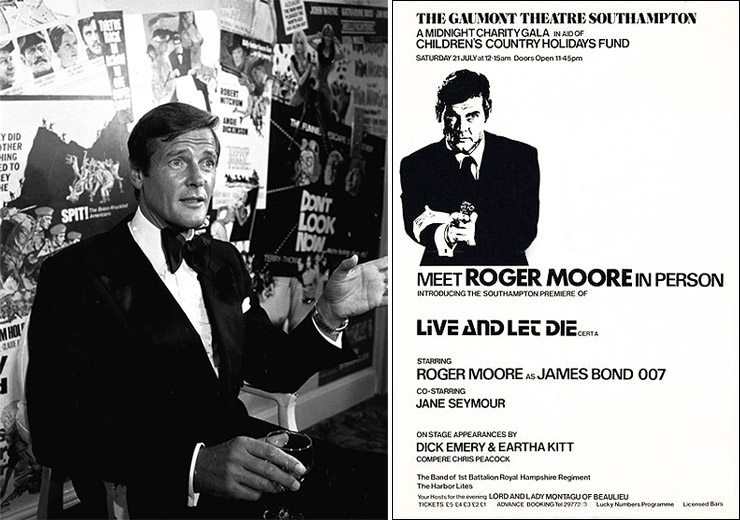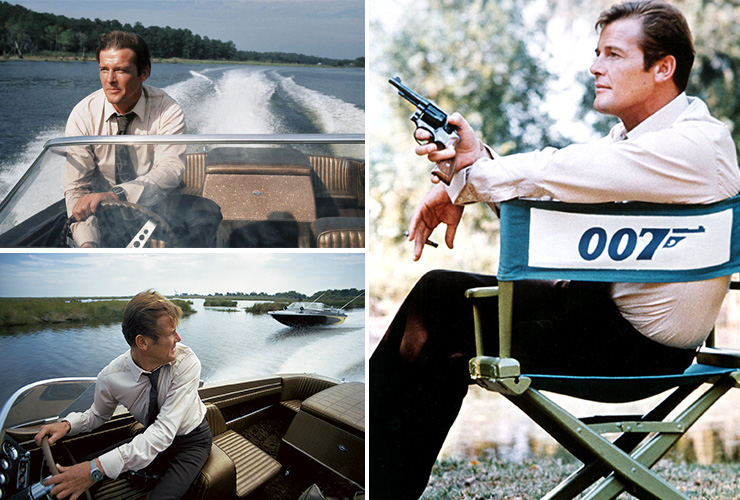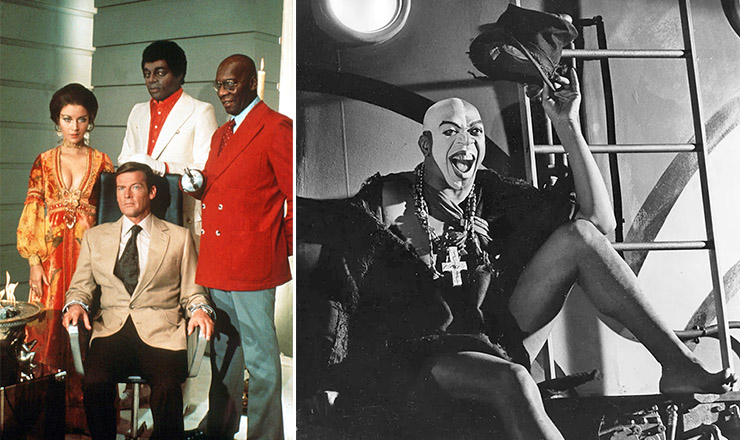|
Live And Let
Die |
||
|
||
|
Live And Let
Die |
||
|
||
 |
||||
|
Three months before the US release of Live And Let Die, new James Bond Roger Moore was hot property, and had his own brush with fame at the 1973 Oscars ceremony when he was asked to present the Best Actor award with Norwegian actress Liv Ullmann. The ceremony was marked by Marlon Brando's boycott of the Oscars and his sending of Sacheen Littlefeather (1946-2022) to explain why he couldn't show up to collect his Best Actor award for The Godfather (1972). |
||||
|
||||
|
Roger Moore’s debut as 007 opened in the USA at Grauman’s Chinese Theatre in Hollywood on June 27, 1973 and across the USA, including engagements at United Artists’ Red Carpet Theatres in New York. Live And Let Die was generally well-reviewed by the US press, which set the stage for the London opening on July 5, 1973. Advertised as the ‘Royal World Charity Premiere’, this was somewhat misleading as the film had already played in the USA and Europe for a week. Held in the presence of Her Royal Highness The Princess Anne, the premiere was attended by Roger Moore and Jane Seymour, but Yaphet Kotto declined to appear. Paul McCartney also attended with wife Linda and his band Wings. David Bowie, Michael Caine, David Frost with Lulu, Burt Reynolds, Peter Sellers, Gregory Peck, Joan Collins, and novelist Alistair MacLean also appeared on the red carpet. Live And Let Die continued to play at the ODEON Leicester Square until September 12th, and also at the London Pavilion for six weeks from Thursday August 30th. Live And Let Die also played simultaneously at the 2,000-seat Metropole Victoria, and 1,650-seat Astoria Charing Cross Road for a staggering 14 weeks from Thursday August 9, 1973. Like You Only Live Twice (1967), which also had a Summer release, Live And Let Die first played at selected coastal resorts from July 12th to take advantage of the school holidays before its general release in mid-August 1973. Live And Let Die played an exclusive six-week season at the Dreamland Entertainment Complex in Margate concurrently with the West End engagement over the summer of 1973. |
||||
|
||||
|
Ahead of the London opening the newspaper publicity machine had ramped up the hype with the Daily Express printing a report on the record breaking boat chase, and Bond’s girls, with the Sunday People serializing Roger Moore’s Live And Let Die diaries ahead of their paperback publication by PAN Books. Live And Let Die was hugely successful at the international box-office, far surpassing the receipts of Sean Connery’s Diamonds Are Forever. EON Productions and United Artists were keen to capitalize on the success and began scouting locations for The Man With The Golden Gun in September/October 1973, with Tom Mankiewicz submitting a first draft screenplay on October 15th. Live And Let Die went on to break box-office records at many provincial cinemas, playing for a staggering 21 weeks at the ODEON in Nottingham, which had been the first UK venue to be split into two screens in 1964. Cinema audiences had been steadily declining for the past 25 years, with many venues converted to Bingo Halls, whilst others had their large auditoriums divided into smaller screens, with many closing altogether. The 2,250-seat ODEON Kings Road in Chelsea had closed on March 11, 1972 with Diamonds Are Forever as the last film screened. The foyer and stalls area were converted into a Habitat furnishing store, with the former stage area turned into flats and offices. A new ODEON cinema with just 739 seats was created from former balcony area, and the venue re-opened on Sunday September 9, 1973 with Live And Let Die as the first film shown. The re-opening was well promoted in London newspapers with Live And Let Die advertised as being held over “For one week Moore!” after a popular first seven days. |
||||
|
||||
|
Two weeks after the London premiere of Live And Let Die its star Roger Moore also attended a midnight charity gala held at the Gaumont Theatre, Southampton, hosted by Lord and Lady Montagu of Beaulieu. Roger Moore was accompanied by his wife, and the event also featured onstage appearances by popular British television comedian and actor Dick Emery (1915-1983), and American singer and actress Eartha Kitt (1927-2008). |
||||
 |
||||
|
With Live And Let Die still playing in provincial cinemas well into 1974, United Artists were still keen to make money off the Sean Connery films before their sale to television. Double-bills of Diamonds Are Forever/From Russia With Love, Dr. No/Goldfinger, and You Only Live Twice/Thunderball all played across the UK in 1974. Live And Let Die was re-released in London at the ODEON St. Martins Lane and Metropole Victoria on June 27, 1974, and then on a double-bill with On Her Majesty’s Secret Service (1969) starring George Lazenby as 007 at the London Pavilion on August 22nd, where it played for four weeks. United Artists never released Roger Moore’s debut with a Sean Connery title during this period, but the pairing with On Her Majesty’s Secret Service was released provincially from late July and proved very popular – with many cinemagoers re-evaluating George Lazenby’s one-off performance as 007, now it could be seen again after a 2½-year absence from cinemas. |
||||
|
||||
|
Live And Let Die was an instant success and proved finally that audiences would accept a new actor in the role, in a way that eluded George Lazenby in On Her Majesty’s Secret Service on its initial release. Like its predecessor Diamonds Are Forever, Roger Moore’s first James Bond film also moved even further away from the Ian Fleming source novel, and some British critics were perhaps a little more astute than their American cousins in their original evaluation of Live And Let Die; George Melly in his review for The Observer on July 8, 1973 regretted that “…all links with Fleming’s cunning exploitation of male fantasy in the fifties and sixties, the realism of technical detail masking the absurd omnipotence of the central figure, have long gone.” Going on to comment: “…on the credit side it means that Fleming’s dubious morality – the sex, sadism and snobbery as Paul Johnson once categorised it — have vanished too, and good riddance.” With the republication of Ian Fleming’s novels in 2023 in edited versions (particularly in the case of LIVE AND LET DIE), perhaps this is a case of history repeating itself. |
||||
 |
||||
|
50 years on, Live And Let Die can be seen as a solid entry in the series, with Roger Moore appearing more or less fully-formed in the lead role he would reprise six times more over the following 12 years, with varying degrees of artistic success. It is hard to believe that any other actor at the time could have pulled off the role so successfully in Live And Let Die – certainly none of the names tested for the James Bond role in 1972 spring to mind. In an alternate universe John Gavin’s one-off take on the role in Diamonds Are Forever probably went the same way as George Lazenby’s, and the franchise ground to a halt. In the real-world Roger Moore consolidated this success with his more urbane, less threatening take on the role. With the films now aimed at a much younger audience, the series went from new heights of outrageous stunts and action sequences, to new depths of juvenile humour and far-fetched plotlines. However, at the centre of it all Moore remained constant, with his tongue firmly in his cheek. Love him, or loathe him, Roger Moore reinvented the James Bond character for a new generation, and of his seven outings Live And Let Die has probably stood the test of time better than the others. With its superbly executed stunt sequences, most notably the boat chase with Moore clearly visible in the frame for much of the action, to the clever re-interpretation of the black villains of Fleming’s original novel, Live And Let Die still remains a fan favourite half a century on. Aided by George Martin’s brassy score (possibly the best non-Barry score of the series), and Paul McCartney’s iconic title song, Live And Let Die delivers what the trailers promised, and is ultimately a more satisfying presentation of the new more mid-Atlantic 007 than its predecessor. Live And Let Die later premiered on the ITV network on January 20, 1980 and still holds the record as the most viewed film on UK television, with a staggering 23.50 million viewers - a record that is likely never to be broken! |
||||
 |
||||
|
Ten years after the release of Live And Let Die, Roger Moore’s penultimate James Bond film Octopussy (1983) also outperformed Sean Connery’s second comeback as 007 in Never Say Never Again at the international box-office. Both films are celebrating their 40th anniversary this year, but in the so-called ‘Battle of the Bonds’, Roger Moore was clearly the winner… twice! |
||||
|
|
||||
|
|